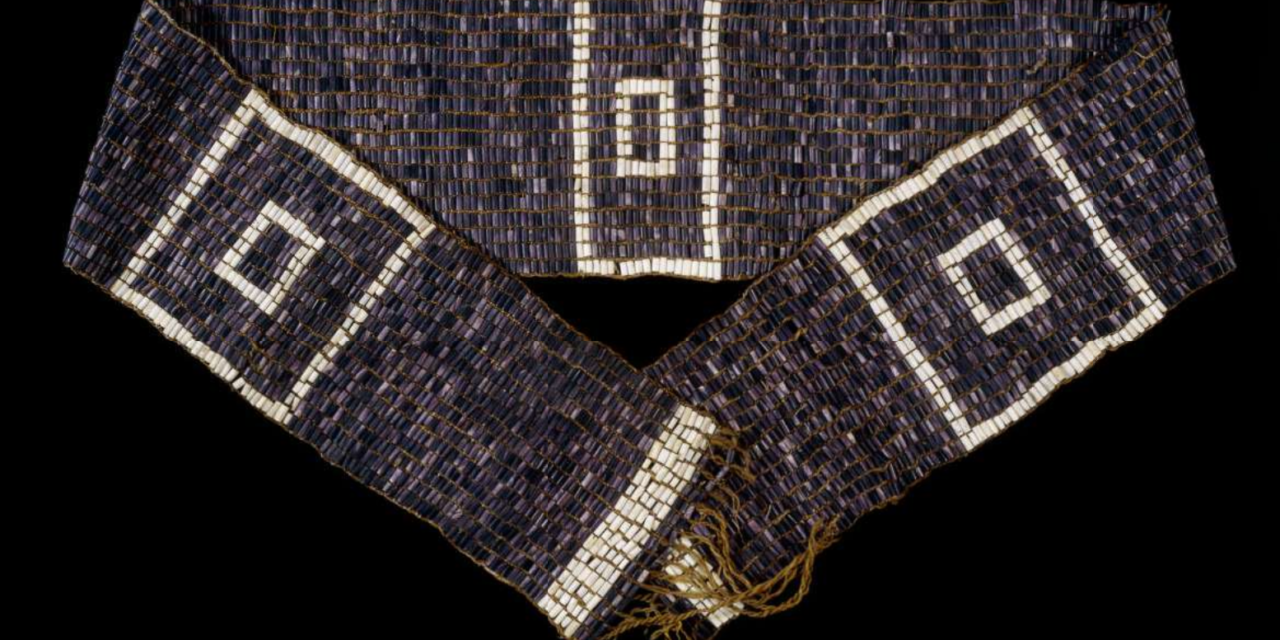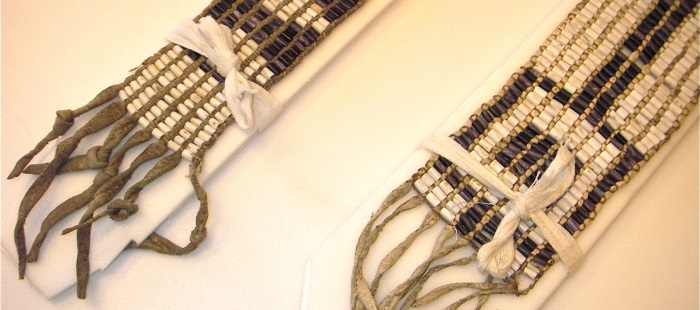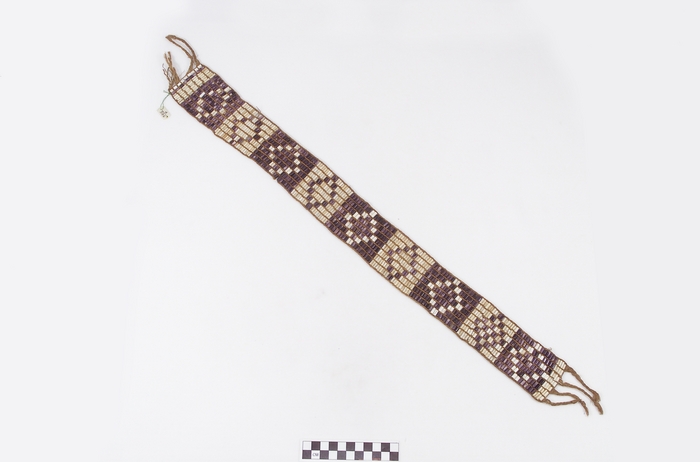Wampum are shell beads strung together by American Indians to create images and patterns on accessories such as headbands and belts that can also be used as currency for trading.
The Details
In the Berg Encyclopedia of World Dress and Fashion (2010), Linda Welters explains the origins of wampum:
“Wampum is an Algonquian word for small shell beads. These were made on the coast of southern New England and Long Island from whelk, which yielded white beads, and quahogs, which produced purple beads. The latter were more valuable. The beads were strung together on two-ply strands of Indian hemp for necklaces or bracelets. The beads could also be woven into bands suitable for use as belts, bandoliers, or headbands.”
As seen in this belt (Fig. 1). wampum is the purple and white shell beads used to create the geometric pattern.
Fig. 1 - Artist unknown (North American Indians). Wampum; belt; bead, Production date 1600-1800. Shell and wool; 127cm in width. London, United Kingdom: British Museum, Am1949,22.119. Worden Hall, Lancashire, by W O Oldman. Source: British Museum
Fig. 2 - Artist unknown (North American Indians). Wampum belt, late 18th-early 19th. McCord Museum, M1913. Gift of David Ross McCord. Source: McCord Museum
In the Berg Encyclopedia of World Dress and Fashion (2010), Carol Anne Dickson notes that wampum was:
“fashioned from polished shell beads, was especially prized for jewelry and also served as currency for trade.”
See, for example, a late 18th century-early 19th century wampum belt (Fig. 2) which features a geometric pattern and two hands imagery at the center front.
The Britannica Concise Encyclopedia describes wampum as:
“Tubular shell beads assembled into strings or woven into belts or embroidered ornaments. The Algonquian word… translates as ‘string of white (shell beads).’ Before contact with white settlers, Indians used wampum primarily ceremonially or in gift exchanges. In the early 17th century it came to be used as money in trade with whites, because of a shortage of European currency.”
A 1790s wampum belt (Fig. 3) is primarily made of white beads, while another alternates the white whelk shell beads with the quahog purple ones in a diamond pattern (Fig. 4).
Fig. 3 - Artist unknown (North American Indians). Wampum belt, 1790s. Source: Penn Museum
Fig. 4 - Artist unknown (North American Indians). Wampum belt, Unknown. Whelk shell beads (white wampum), quahog clam shell beads (purple wampum), hide thong/babiche, cordage. New York, New York: National Museum of the American Indian, 4/386. Emil Schlup, Non-Indian, 1854-1935. Source: National Museum of the American Indian
References:
- Dickson, Carol Anne. “The Jewelry Industry.” In Berg Encyclopedia of World Dress and Fashion: The United States and Canada, edited by Phyllis G. Tortora, 149–159. Oxford: Bloomsbury Academic, 2010. Accessed March 10, 2021. http://dx.doi.org/10.2752/BEWDF/EDch3022.
- Welters, Linda. “The Northeast.” In Berg Encyclopedia of World Dress and Fashion: The United States and Canada, edited by Phyllis G. Tortora, 447–456. Oxford: Bloomsbury Academic, 2010. Accessed March 10, 2021. http://dx.doi.org/10.2752/BEWDF/EDch3059.
- “Wampum.” In Britannica Concise Encyclopedia, by Encyclopaedia Britannica. Britannica Digital Learning, 2017. https://libproxy.fitsuny.edu/login?url=https://search.credoreference.com/content/entry/ebconcise/wampum/0?institutionId=2614














